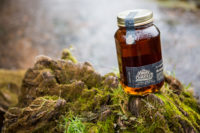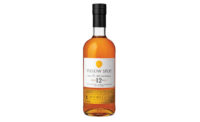The romanticism of history is what keeps books like “The Great Gatsby” popular with today’s youth, but that same glamorization also is taking shape in the spirits category within the latest emerging segment: moonshine.
“The role of moonshine in the spirits category operates on a couple of levels,” says Joe Michalek, founder and president of Piedmont Distillers Inc., Madison, N.C. “First, moonshine is liquid Americana. The spirit is intrinsically tied to American history. There’s no other liquor on shelves that has had a bigger impact on our country’s heritage than moonshine. And second, it offers spirits consumers something truly unique.”
These qualities could be contributing to moon-shine’s increasing presence in the consumer packaged goods market. According to Richard Hurst, practice leader for beer, wine, spirits and tobacco for Chicago-based Information Resources Inc. (IRI), volume sales of the spirit during the last three years were up an average of 150 percent in liquor channels. Multi-outlets fared even better with volume growth at 230 percent, based on IRI data.
However, even with that growth, the sub-segment still accounts for only 0.5 percent of the overall whiskey segment with recorded sales of approximately $9 million for the 52 weeks ending Feb. 16 in IRI-tracked channels, Hurst says. In comparison, whiskey sales were $2 billion, and overall spirits sales were
$7 billion in that timeframe.
Standing out in the crowd
Although moonshine is well-known for its illicit history, it features similarities to whiskey and, more specifically, bourbon but with a few key differentiators.
“Moonshine is generally defined as unaged corn whiskey,” Hurst says. “Labels will typically refer to ‘corn whiskey’ or ‘spirit whiskey.’” But unlike bourbon and other internationally recognized whiskeys, moonshine can be sold shortly after distillation, he adds. This dearth of aging leaves the spirit clear. Although brown spirits are particularly popular among consumers right now, moonshine’s color differentiator has not limited its appeal.
“While moonshine does not, therefore, automatically benefit from the trend to brown spirits by virtue of its color, it is still perceived, especially by younger consumers, as a form of whiskey,” Hurst says.
The millennial generation is helping to drive the growing acceptance of moonshine, distillers note. John Cochran, chief executive officer of Ole Smoky Distillery, Gatlinburg, Tenn., says that consumers in the 21-35- year age group are embracing the spirits category and gravitating toward whiskey and other brown spirits. However, these consumers also have developed an affinity for products that are more commonly associated with older generations. “They really have a respect and interest in products that their grandfathers or their great-grandfathers drank,” he says.
Cochran adds that the craft spirits trend has had a similar effect on moonshine. “Craft spirits are on the rise, and moonshine is definitely a craft spirit from the same standpoint that it’s made in small batches, literally handcrafted and hand-packed in [a] very traditional fashion,” he says. “We see the whole emergence of craft spirits kind of like [how] craft beer started to emerge seven or eight years ago, [so] we’re benefiting from that.”
IRI’s Hurst explains that the craft spirits trend also resonates with millennials and could bode well for moonshine in the future. “Moonshine is likely to have natural appeal to the younger, millennial consumer due to its rebellious nature and the hand-crafted nature of its production,” he says.
Hurst adds that TV series such as “Moonshiners,” a reality show on the Discovery Channel that follows people who illicitly distill moonshine within their respective territories, also have added to the segment’s allure.
Chris Sellers, chief operating officer of Prost Beverage Co., Fort Pierce, Fla., affirms this pop culture influence. “A number of popular TV shows, songs and movies have depicted the life of a moonshiner in the history of our country all the way up until today,” he says. “Everyone seems to be getting their ‘shine’ on.”
Prost took that influence a step further by partnering with “Moonshiners” cast member Tim Smith to develop Tim Smith’s Climax Moonshine. “Our vision was to bring a super-premium product to the moonshine category, and the ‘Moonshiners’ program on [the] Discovery Channel depicted Tim Smith as the best moonshiner around these parts,” Sellers notes. Released in August 2013, Tim Smith’s Climax Moonshine is available in Original, Peach and Grape varieties.
Bourgeoning selection
Although pop culture and adventurous millennials might be driving the trends, it’s the distillers’ creativity that is setting the stage for moonshine’s growth.
“The rapid growth of moonshine is most likely attributable to a combination of a growing number of available brands and variants, including flavors,” IRI’s Hurst says. He adds that increased distribution both geographically and across channels is another key contributor.
Earlier this year, Ole Smoky appointed Miami-based Monarq Group as the exclusive importer of Ole Smoky Tennessee Moonshine to Latin America, the Caribbean and U.S. duty-free retailers. The brand already is available in 49 states and Canada.
Hurst notes that Ole Smoky currently dominates the segment in both liquor and multi-outlet channels with 98 percent share in dollar sales and 97 percent share in case sales, according IRI data. With nine varieties in its current portfolio following the February release of a Pineapple flavor in Hawaii, California and its Tennessee distillery, Ole Smoky has achieved sales across a range of flavors, Hurst notes.
The rest of the portfolio includes Original, Apple Pie, Blackberry, Cherries, Lemon Drop, White Lightnin’, Peach and Strawberry. “Apple Pie is our No. 1 SKU,” Cochran says. “The No. 2 SKU is our Cherries, where we take half of a jar of White Lightnin’ and we take Maraschino cherries and we fill the jar. It [contains]about 100 cherries. It’s an unbelievably great product.”
Its non-flavored varieties — Original and White Lightnin’ — bounce back and forth between the No. 3 and No. 4 spots, Cochran adds. “The only difference between those two products is we distill the Original twice, so [it has] a very traditional flavor profile with more of a nice, smooth corn flavor and finish to it, and then the White Lightnin’ we distill six times, so it’s pretty cleaned up and very mixable,” he explains. “We use White Lightnin’ in place of vodka in any drink you can imagine.”
The company also launched its first aged product in March called Charred. “We’re very excited about it, because it’s a lightly aged ‘shine where it’s a slightly different grain build,” Cochran says. The formulation is 80 percent corn, but some of the rye is replaced with wheat, he adds. After distillation, it is aged in bourbon barrels for three to four months.
The company also has some limited summer releases slated to hit the market around Memorial Day. It is producing 5,000 cases each of Watermelon and Sweet Tea, which will be available from Memorial Day through Labor Day, Cochran says.
But Ole Smoky isn’t the only company to explore flavored moonshines. Piedmont Distillers’ Midnight Moon brand is made up of six fruit-infused flavors as well as two unflavored varieties: an 80-proof moonshine and a 100-proof moonshine.
“Our best-selling flavor is Apple Pie followed by Strawberry and Cherry,” Michalek says. “The Midnight Moon fruit flavors are crafted by hand-filling each jar with actual fruit. All of the flavor and color in these spirits come from the fruit itself — just as nature and moonshiners intended.” Blueberry, Cranberry and Blackberry flavored moonshines round out the rest of its lineup.
The company also developed a spiced moonshine called Catdaddy. “Like Midnight Moon, Catdaddy is made from corn; however, its flavor profile is unique as it is infused with a proprietary blend of all-natural spices and flavors,” Michalek says. “The result is an incredibly smooth spirit with hints of vanilla, nutmeg and cinnamon.”
Both brands have been well received by consumers, with Midnight Moon experiencing triple-digit growth year-over-year during the past several years and Catdaddy recording triple-digit growth from 2009 through 2013, he notes.
“The core to our success is that consumers can now buy our authentic, high-quality moonshine in stores without fear of the law,” Michalek says.
But flavors aren’t the only thing these beverage-makers are hanging their hats on. Prost notes that although its Tim Smith’s Climax Moonshine offers Peach and Grape varieties, the Original is its best seller. “We really want everyone to taste our core SKU, the Original, because it is such a point of difference with the competitive set,” Sellers says.
And despite its short time in the market, the brand has seen early success since its launch last year. “Our monthly production run has sold out every month and since November has sold out in one day,” Sellers says. “We have contracted a new distillery that will be coming online in the next 60 days — [in] May 2014 — that will help solve our supply problems.”
With shared success throughout the sub-segment, other distilleries also are looking to put their own creative stamp on moonshine. Cape Coral, Fla.-based Cape Spirits Inc. will launch its own take on the spirit — RumShine — at the end of April in retailers throughout Florida.
“My influence in developing RumShine really started while exploring the history of Florida and rum in Florida,” President JoAnn Elardo says. “While they were planting the sugarcane fields in Florida, the men working them developed their own spirits. We call it RumShine.”
Elardo notes that while whiskey-based moonshine comes from corn, RumShine is distilled from pure Florida sugarcane and has a rich, sweet taste with a fruity finish.
Even though much of the innovation within the sub-segment is being fueled by independent distillers, IRI’s Hurst says this could change going forward. “This category lends itself best to independent distillers; however, as with other craft spirit categories, it is not impossible that larger companies will enter the market through acquisition or innovation.”
Shining on
Although moonshine is surging, distillers understand that more work needs to be done to reach the masses.
“I think what we’re seeing is there’s a real interest in moonshine,” Ole Smoky’s Cochran says. “If there’s any challenge to this whole thing, it’s to educate people on what moonshine is and how to enjoy it.” The brand is achieving this through its outdoor, point-of-sale materials and TV commercials utilizing the tagline “Have some friends.”
“The idea is this is for friends and for family and for enjoying with people, and it’s sort of a call to action in terms of the tagline, but it really is what the brand is about,” he says.
Piedmont also is investing in its brand awareness. “The brand has engaged in a variety of marketing initiatives including advertising, public relations, social media, event sponsorship, and on- and off-premise promotions,” Michalek says. “Last year, we launched our first large-scale national print advertising campaign, which was followed by our first 30-second television spot dubbed the ‘Original ‘Shine Runner.’”
And with the ability to leverage Smith’s visual presence and personality, Prost has benefited from the celebrity moonshiner’s enjoyment of reaching out and talking with consumers at public appearances. “It is fun and always exciting,” Sellers says. “He wears his military hat, as a tribute to his fellow servicemen and women, and his shirtless overalls, so he is instantly recognizable as the ‘Moonshine Man.’”
Charity also is a key component of the young Tim Smith’s Climax Moonshine brand. “We have teamed up with the National Fallen Firefighters [Foundation] and will donate $1 of every 9-liter case sold to this charity as Tim is very serious about his charitable contributions,” Sellers says.







